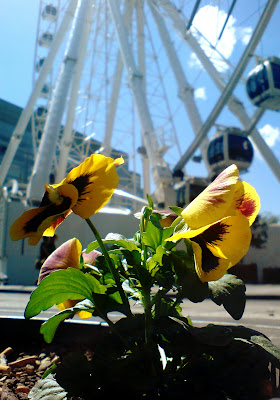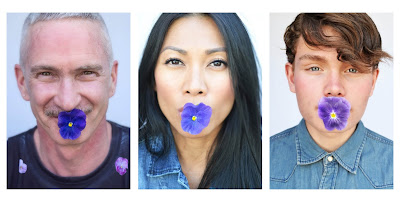T.R.I.P. } ponderings

Culturally the place for extended thought and debate is increasingly liminal; the TRIP and LRM organisers were keen to create a space for discussion that illuminated the city. From the MMU campus where papers were presented to walks and events that took place on the streets enabling walking and talking to take place simultaneously allowing the interested few to discuss the complexities of urban experience whilst experiencing Manchester from URBIS to Britons Protection.
As The Pansy Project I led a selection of TRIP participants on a walk around Manchester showing the places where I had planted pansies, enabling people to witness the plantings at the various sites where I had experienced homophobia over the last few months, Chris Buckley and Maureen Ward also accompanied the group prior to their papers being presented as part of the conference. Chris Buckley was busy filming the activity for his ongoing anthropological and ethnographic research and Maureen Ward was on hand to eloquently contribute to the discussions that were generated from the other participants as they responded to the spectacle of me planting pansies on the street.
"Fucking Faggot!" Piccadilly Gardens, Manchester
As I somewhat bluntly explained the experience of homophobia to the collected participants; “here was where someone screamed ‘POOF!’ in my face” and here was where people shouted ‘Fucking Faggot!’ from a passing car”. I would continue to dig away forcing my trowel into the compacted soil at the base of various trees simultaneously engaged with and disengaged from the activity; my main focus being the planting and photographing of the pansies for my blog and website.
After the plantings we went back to Apartment to discuss the activity and to enable the participants to see some finished photographs pasted on the walls of the flat, the same walls I had placed photographs experimentally on three years previously. As I returned to the flat and saw the photographs pasted to the wall I recalled the thousands of pansies that I had planted across the world over the past three years from
"Fucking Faggot!..Queer Bastard!...Bender!" Exchange Square, Manchester
As part of their separate research projects Maureen Ward and Chris Buckley collated material for the papers on The Pansy Project which they presented at TRIP; both were intelligent explorations of the issues The Pansy Project seems to reveal. From sited anti-memorial to cathartic ritualistic strategy both papers reflected on the nature of the project as a catalyst for discussion. Within the context of the TRIP conference the lack of position appeared to be problematic. It seemed to some of the audience that the reading of The Pansy Project potentially objectified the heteronormative mass as aggressor. An unfortunate conclusion, as someone who regularly experiences homophobia and who is forced to deal with this as an ‘everyday’ reality it is a challenge and symptomatic of the insidious effects of hate crime that one does not come to expect this display of hatred from innocent passers-by. The experience of hate crime attempts to transform the logical mind into one filled with fear and dread as is evident today in a wider context when the media comes to refer to all ‘Hoodies’ as yobs and criminals.
Academia also seemed to require The Pansy Project to adopt a position as potential solution to the problem of homophobia on the street. As an artist I see art as an ideal backdrop for the examination of these complex issues without necessarily suggesting a solution. This academic context has rightly challenged The Pansy Project and I intend to continue to research and consider its wider position.
The experience of the conference has encouraged me to re-examine The Pansy Project and to contemplate the development of it as an artwork. Increasingly the complexity of the project and its various readings tends to alienate me from my own work. On contemplating the various responses over the past three years I find myself thinking about what the project means to me as artist and as a citizen and my position within a heteronormative world that appears, at best to tolerate my existence and at worst wish me ill or worse.
As I consider these issues I am reminded of my own childhood attempts to beautify an abandoned path at the side of my house. Both the front and back gardens of my childhood home were overgrown wastelands, a source of embarrassment and shame, evidence of a troubled home-life that I wished to conceal from my school friends. I remember that on one particular day my mother began to tackle the approaching wasteland and started to weed along the side of the house, she had already trimmed a small patch of grass in the back garden choosing to ignore the rest which continued to develop into an abandoned mini meadow. I was keen to assist in this action as I saw it as a way out of intense domestic disorder. So I helped plant small annuals in the freshly weeded flower beds hoping that it signified change.
Amongst the wider context of the unkempt garden this seemed irrational at best, though from my current perspective it seems to reveal a personal need to ‘do something’ however illogical or futile to make my own version of the world better. It seems to me that any action is better than no action and in some way The Pansy Project does act as a cathartic strategy that prevents me from feeling overwhelmed by the hatred I come across.
I suspect that this may position me as aggressor or at least as someone not willing to accept the status quo. The problem for a heteronormative mass is that a single member of it does not want to be singled out as homophobe; especially if they are not, though one must be able to critique the mass in order to challenge it, even if it means alienating the ‘innocent’ bystander. Any minority’s strategy that confronts a majority is in danger of alienating its allies, though most would see the ‘greater good’ as long as they fully empathise with those that continue to experience injustice.
I continue to contemplate and welcome constructive comments!



